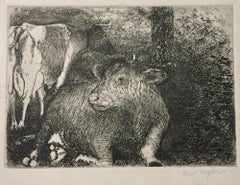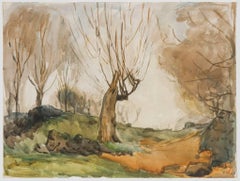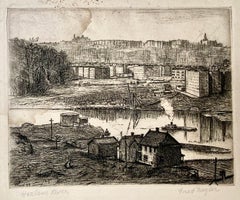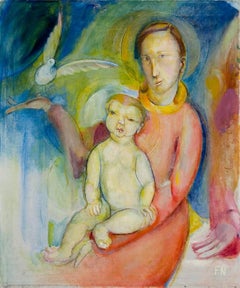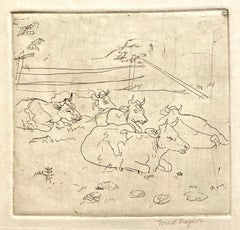Fred Nagler Art
to
7
1
Overall Width
to
Overall Height
to
8
5
3
6
2
3
2
2
1
1
1
1
1
1
1
1
1
5
3
2
2
2
8
8,779
2,809
1,642
1,313
8
Artist: Fred Nagler
Untitled
By Fred Nagler
Located in Dallas, TX
Fred Nagler was born in 1891 in Springfield, Massachusetts, where he first studied wood carving. From 1914 to 1917, he studied at The Art Students League of New York, where his prof...
Category
20th Century American Modern Fred Nagler Art
Materials
Graphite, Paper, Watercolor
Fred Nagler, (Cows in a Pasture)
By Fred Nagler
Located in New York, NY
Massachusetts-born Fred Nagler studied at the Art Students League from 1914 to 1917, with George Bridgeman and Robert Henri, and eventually became a member of the Board of Control. He taught at the Connecticut College for Women, and after the death of Grant Wood, the University of Iowa State...
Category
1920s Ashcan School Fred Nagler Art
Materials
Etching
Untitled (Tree)
By Fred Nagler
Located in Dallas, TX
Fred Nagler was born in 1891 in Springfield, Massachusetts, where he first studied wood carving. From 1914 to 1917, he studied at The Art Students League of New York, where his prof...
Category
20th Century American Modern Fred Nagler Art
Materials
Graphite, Paper, Watercolor
Fred Nagler, Harlem River (New York City)
By Fred Nagler
Located in New York, NY
Massachusetts-born Fred Nagler studied at the Art Students League from 1914 to 1917, with George Bridgeman and Robert Henri, and eventually became a member of the Board of Control. ...
Category
1920s Ashcan School Fred Nagler Art
Materials
Etching
Releasing the Dove
By Fred Nagler
Located in Dallas, TX
Fred Nagler was born in 1891 in Springfield, Massachusetts, where he first studied wood carving. From 1914 to 1917, he studied at The Art Students League of New York, where his profe...
Category
Mid-20th Century American Modern Fred Nagler Art
Materials
Canvas, Oil
Fred Nagler, (Crucifixion)
By Fred Nagler
Located in New York, NY
The etching (Crucifixion) is signed and titled in pencil. Signed 'Fred' and possibly dated '27' in the image at lower left.
It's in an usually spare drawing style but one that Nagl...
Category
1920s Ashcan School Fred Nagler Art
Materials
Etching
Fred Nagler, (Road to Calvary)
By Fred Nagler
Located in New York, NY
The etching (Road to Calvary) is signed in pencil.
It's in an usually spare drawing style but one that Nagler did use occasionally. Here it emphasizes the meagerness of the scene. T...
Category
1920s Ashcan School Fred Nagler Art
Materials
Etching
Fred Nagler, (Sheep under a Tree)
By Fred Nagler
Located in New York, NY
The etching (Sheep under a Tree) is signed in pencil and annotated (in lower margin) '3rd State, 4 proofs, JN imp.' in pencil.
It's in an usually spare drawing style but one that Na...
Category
1920s Ashcan School Fred Nagler Art
Materials
Etching
Related Items
mr. c and gladys, bright colorful man and dog
By Stephen Basso
Located in Brooklyn, NY
*ABOUT Stephen Basso
Stephen Basso's highly original pastels and oil paintings are romantic, yet thought provoking fantasies. His whimsical works are alive with boundless imagina...
Category
2010s American Modern Fred Nagler Art
Materials
Canvas, Oil
$1,500
H 24.02 in W 24.02 in D 0.99 in
Brookdale, New Jersey
By Oscar Florianus Bluemner
Located in Fairlawn, OH
Brookdale, New Jersey
Graphite on paper, 1922
Signed with the artist's initials l.l., and dated 1922 (see photo)
Annotated "Brookdale" front and back of sheet
Condition: Excellent
Ar...
Category
1920s American Modern Fred Nagler Art
Materials
Graphite
"NY Street Signs" Mid-20th Century WPA 1938 Modernist Abstract Realism Pop Art
By Stuart Davis
Located in New York, NY
"NY Street Signs" Mid-20th Century WPA 1938 Modernist Abstract Realism Pop Art
Stuart Davis (American, 1892-1964) "Street Signs" Modernist gouache and traces of pencil on paper in the proto-pop art style Davis is celebrated for, 1938, signed to lower right, framed. Image: 11 1/4 x 15 1/4 inches. Frame by Bark: 18 1/2 x 22 inches.
LITERATURE: A, Boyajian, M. Rutkowski, Stuart Davis, A Catalogue Raisonne, Vol. 2, New Haven, Connecticut, 2007, vol. II, p. 632, no. 1232, illustrated.
EXHIBITIONS: ACA Galleries, New York American Artists' Congress: Group Exhibition of Paintings and Sculpture, Dec. 3-16, 1939 (SDAB I, 12/3/39, p. 129). Outlines Gallery, Pittsburgh, Stuart Davis, Mar. 3-16, 1946. Coleman Art Gallery, Philadelphia, 5 Prodigal Sons: Former Philadelphia Artists: Ralston Crawford, Stuart Davis, Charles Demuth, Julian Levi, Charles Sheeler, Oct 4 - 30, 1947 (pamphlet), no. 12.
PROVENANCE: The artist; Mr. and Mrs. Frank Bowles, New York, Apr. 3, 1956; thence by descent, Private Collection, New York.
NOTES: According to the Catalogue Raissonne, "the title 'Street Signs' is recorded in the artist's account books...
Category
1930s American Modern Fred Nagler Art
Materials
Paper, Gouache, Pencil
$125,000
H 18.5 in W 22 in D 1 in
Chapel and houses along a lake, New England Landscape - American School, 19th C
Located in Middletown, NY
Watercolor and pencil on buff wove watercolor paper, 10 x 8 inches (255 x 203 mm). In good condition with overall minor toning. Some watercolor paint splatters on the verso, contem...
Category
Early 1900s American Modern Fred Nagler Art
Materials
Watercolor, Pencil
Mid Century Modern Cubist Geometric Abstract Oil Painting - The Henkeeper
Located in Bristol, GB
THE HENKEEPER
Size: 76.5 x 61.5 cm (including frame)
Oil on canvas
A striking mid-century modernist painting depicting a woman tending to a group of chickens, rendered in a bold, ab...
Category
Mid-20th Century Modern Fred Nagler Art
Materials
Canvas, Oil
$1,411
H 30.12 in W 24.22 in
Island Light, by Stephen McMillan
By Stephen McMillan
Located in Palm Springs, CA
Medium: etching and aquatint
Edition of 120
Year: 2023
Image Size: 4 x 5 inches
Signed, titled and numbered by the artist.
The view west from Cypress Island off the coast of Washin...
Category
2010s Contemporary Fred Nagler Art
Materials
Etching, Aquatint
New Sun VI
By Robert McCauley
Located in Bozeman, MT
When I think of where McCauley fits into American art, as a contemporary painter, sculptor and naturalistic interpreter, I place him in the same philosophical tribe as Walton Ford, A...
Category
2010s American Modern Fred Nagler Art
Materials
Canvas, Oil, Wood Panel
Rapunzel, Rapunzel, let down your hair David Hockney Brothers Grimm Fairy Tales
By David Hockney
Located in New York, NY
From David Hockney’s celebrated Six Fairy Tales from the Brothers Grimm portfolio, an image from the story of Rapunzel, which he chose for its popularity. When illustrating the princ...
Category
1960s Modern Fred Nagler Art
Materials
Etching, Aquatint
Tim Southall, Ravens at the Tower, Etching, Affordable Art, Art Online
By Tim Southall
Located in Deddington, GB
Tim Southall
Ravens at the Tower
Limited Edition Etching and Aquatint
Edition of 75
Image Size: H 10cm x W 15cm
Sheet Size: H 20cm x W 24cm x D 0.1cm
Sold Unframed
Please note that i...
Category
21st Century and Contemporary Contemporary Fred Nagler Art
Materials
Paper, Etching, Aquatint
$297
H 7.88 in W 9.45 in
The Glass Mountain by David Hockney (Six Fairy Tales from the Brothers Grimm)
By David Hockney
Located in New York, NY
This etching from David Hockney’s celebrated Six Fairy Tales from the Brothers Grimm portfolio depicts the somewhat obscure story Old Rinkrank, which Hockney chose to illustrate beca...
Category
1960s Abstract Expressionist Fred Nagler Art
Materials
Etching, Aquatint
$1,500
H 24.75 in W 17.75 in
John Lear Male Nude American Modernist Watercolor Landscape Gay Male Nude
Located in New York, NY
John Brock Lear, Jr., an American Modernist artist from Philadelphia, Pennsylvania. His works are in the collections of the Philadelphia Museum of Art, the Woodmere Art Museum, the D...
Category
Late 20th Century American Modern Fred Nagler Art
Materials
Graphite
The Church Tower and the Clock by David Hockney Brothers Grimm Fairy Tales
By David Hockney
Located in New York, NY
From David Hockney’s celebrated Six Fairy Tales from the Brothers Grimm portfolio, an image from the story of ‘Fundevogel’. This etching is from the Brothers Grimm tale of ‘Fundevoge...
Category
1960s Fred Nagler Art
Materials
Etching, Aquatint
Previously Available Items
Fred Nagler, (Cows in a Pasture, small version)
By Fred Nagler
Located in New York, NY
Massachusetts-born Fred Nagler studied at the Art Students League from 1914 to 1917, with George Bridgeman and Robert Henri, and eventually became a member of the Board of Control. He taught at the Connecticut College for Women, and after the death of Grant Wood, the University of Iowa State...
Category
1920s Ashcan School Fred Nagler Art
Materials
Etching
Fred Nagler art for sale on 1stDibs.
Find a wide variety of authentic Fred Nagler art available for sale on 1stDibs. You can also browse by medium to find art by Fred Nagler in etching, paint, graphite and more. Much of the original work by this artist or collective was created during the 20th century and is mostly associated with the modern style. Not every interior allows for large Fred Nagler art, so small editions measuring 5 inches across are available. Customers who are interested in this artist might also find the work of Louis Conrad Rosenberg, George Biddle, and James Penney. Fred Nagler art prices can differ depending upon medium, time period and other attributes. On 1stDibs, the price for these items starts at $400 and tops out at $14,000, while the average work can sell for $600.

